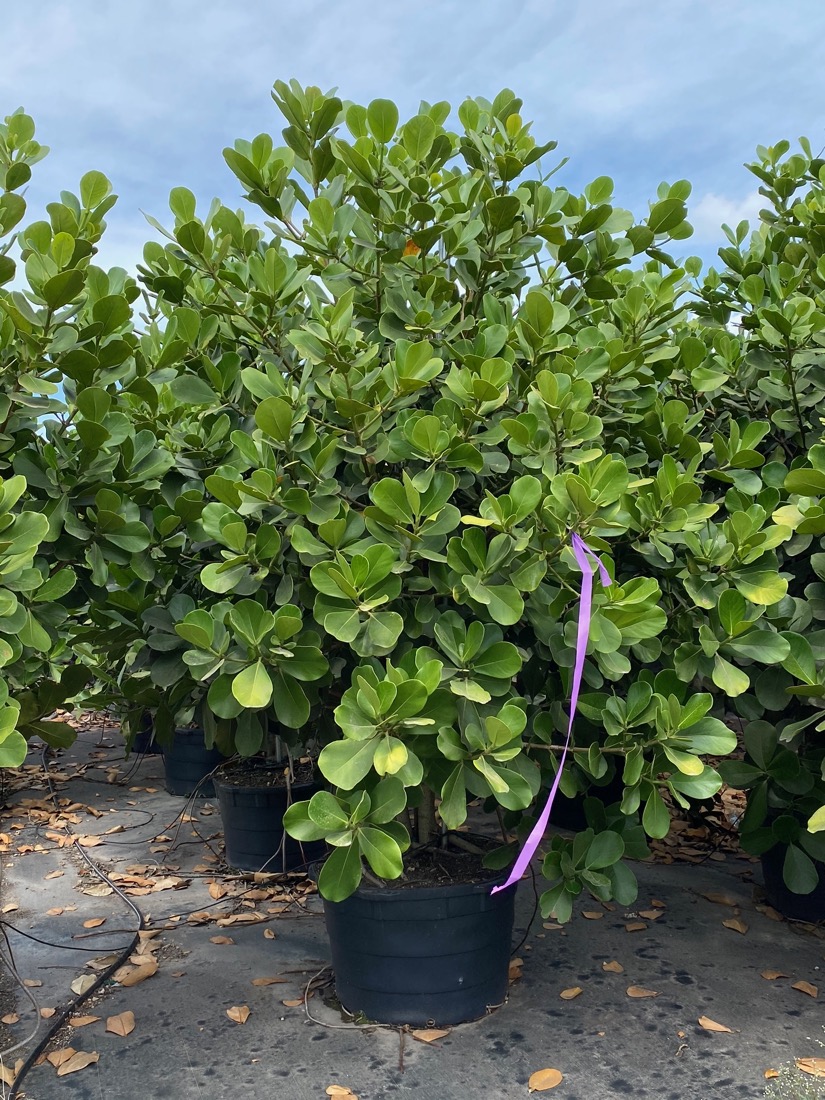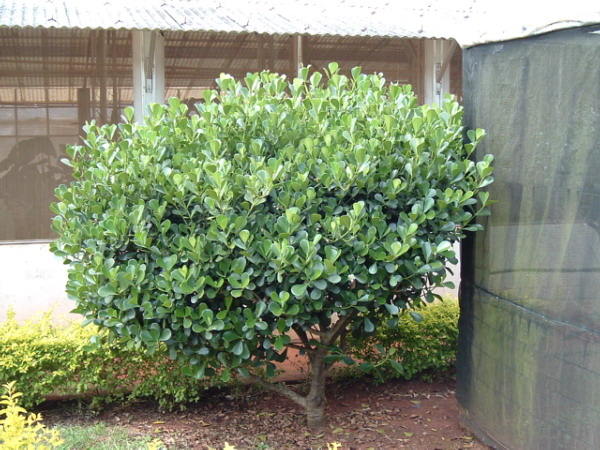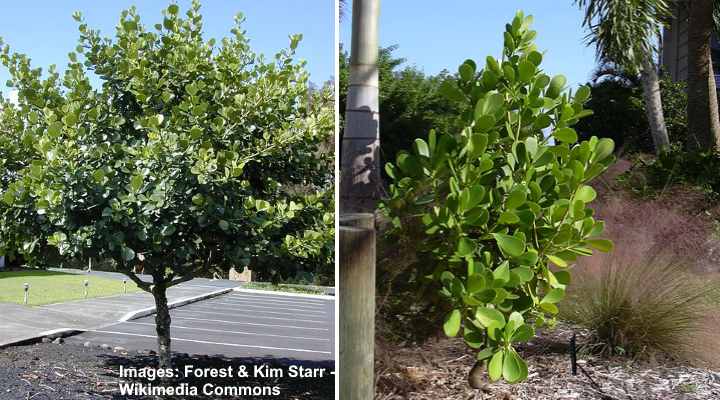Clusia, scientifically known as Clusia guttifera, is an evergreen hedge or screening plant with thick foliage consisting of oval, teardrop-shaped leaves. Due to its minimal upkeep, fast growth, and salt, drought, and heat resistance, Clusia is a popular choice for privacy screens.
Clusia thrives in full sun in warm regions and requires frequent watering and well-draining soil. Clusia shrubs have paddle-shaped leaves that give them an informal, dense appearance.
While Clusia hedges can grow over 6 feet tall, they can be trimmed to maintain a height of 5 to 6 feet. Clusia rosea, a large tree with Clusia-like leaves, is another variety of Clusia. Clusia rosea ‘Nana’ is a dwarf version that can grow into a lush, bushy hedgerow when planted closely together. For comprehensive care instructions on growing Clusia hedges, refer to this article.
Clusia Tree (Clusia rosea)

In the left picture, we can see a medium-sized flowering tree called Clusia rosea which is native to tropical America. The tree can grow up to 65 feet (20 meters) tall and is commonly known as the signature tree or pitch apple. The dense evergreen foliage of Clusia tree has thick olive-green, oval-shaped leaves.
On the right, there is a picture of the dwarf Clusia tree, also known as Clusia rosea ‘Nana’. This tree is a smaller variety of Clusia that only grows up to 3 feet (1 meter) tall and makes an excellent hedge.
Clusia Hedge (Clusia guttifera)

Clusia shrub (Clusia guttifera)
Clusia guttifera, commonly known as small-leaf Clusia, is a popular choice for hedge plants in tropical countries. This shrub produces low branches that can grow up to 25 feet (7.5 meters) tall, serving as a natural evergreen barrier. However, the height is usually managed by regular pruning to keep it at a more manageable height of 5 feet (1.2 meters).
Aside from being an effective privacy screen, Clusia hedges also serve as an excellent addition to any landscape design. The glossy-green leaves of the small-leaf Clusia make it perfect for placing around a patio, fence, or as a specimen plant. Clusia shrubs can also be grown in containers, making it a versatile plant suitable for any gardening style.
How to Care for Clusia Hedge
Now, let’s examine ways to keep Clusia hedgerows looking great all year long by caring for them properly.
Light Requirements for Growing Clusia Guttifera Hedges
Small leaf Clusia shrubs are sun-loving plants that require full sun to thrive. Clusia hedges can be grown in areas that receive six to eight hours of sunlight each day. Regular watering is necessary to keep Clusia plants healthy in hot and sunny conditions. However, Clusia can also grow well in partial shade.
The Best Soil for Planting Clusia Hedges
Clusia plants are not picky about soil and can thrive in most soil types. They prefer soil that is rich and well-draining, and organic matter can help retain moisture in the soil. Coarse horticultural sand or perlite can also be added to improve drainage if needed.
In coastal regions, Clusia plants grow best on fertile ground but can still thrive in poor soil conditions. Their thick, leathery foliage makes them relatively salt-tolerant, making them ideal for coastal landscapes. Additionally, Clusia hedges are suitable for areas where the soil is not suitable for other plants.
Clusia Hedges Watering Needs
To ensure the healthy growth of small leaf Clusia, watering is crucial, even though they are drought-tolerant shrubs. It is recommended to water the plants regularly in the first year after planting, allowing the soil to partially dry out between watering.
Once established, Clusia hedges thrive in dry spells but still require proper watering. When watering the hedge roots after a dry spell, make sure to water thoroughly so that the soil is moist enough to sink into it. Clusia hedge plants can survive drought as long as they get enough water, but they grow and thrive when they receive proper watering.
Proper watering is particularly important for Clusia hedges after the first year of planting. It is recommended to provide around 5 quarts (5 liters) of water for every 3 feet (1 meter) of hedge. Water at least twice a week until the Clusia hedge plants are established, and water more often during hot weather to prevent drying out.
Temperature & Humidity
Clusia hedges are typically found in USDA zones 10 and 11, and can withstand outdoor temperatures as low as 30°F to 40°F (-1°C to +4°C).
However, they prefer temperatures of around 50°F (10°C), which are similar to the average winter temperatures in Miami. With a humidity level above 50%, these low-maintenance evergreen hedges thrive in warm tropical environments.
For those who keep autograph trees (Clusia rosea) as indoor plants, typical indoor room temperatures are ideal. To increase humidity and moisture, mist the leaves every few days and water the plant only when the soil is mostly dry.
How to Plant Clusia Hedge
To create a Clusia guttifera hedge, it is recommended to use small, healthy plant shrubs. When installing an evergreen hedgerow, plant stems should be at least 5 feet (1.2 m) apart, so it is important to ensure you have enough plants. Before planting Clusia, soil preparation is essential, which involves making it fertile and well-draining.
To create a formal hedge, plant the shrubs 5 feet (1.2 meters) apart. However, if you prefer a less structured natural barrier, you may space the plants farther apart. It is important to leave enough room between shrub stems for foliage to breathe and develop by spacing them out. The best time to establish a new Clusia hedge is in the spring, right before the flowering season.
How to plant the Clusia hedge:
- Along the line of the new Clusia hedge, dig holes at least 5 feet apart.
- The Clusia root ball should be three times as big as the holes, which should be as deep.
- The Clusia plant should be carefully removed from its container.
- Fill the remaining space with organic-rich soil and place the Clusia plant in the hole.
- Make sure the new Clusia shrub is firmly planted in the ground by packing it tightly.
- Water the hedge for at least 15 minutes to ensure that it is thoroughly watered.
- Around the base of the shrub, place a 2″ (5 cm) layer of mulch, with at least 4″ (10 cm) of exposed soil surrounding the shrub’s main stem.
- Over the next two weeks, thoroughly water the Clusia hedge.
- Until the shrubs are established, thoroughly water the Clusia hedge every week.
Wait until the soil has somewhat dried before drenching the area for normal watering. To test if the top 2 to 4 inches (5 to 10 cm) of soil is dry, you may do so. Give the Clusia a thorough watering if there are no indications of moisture.
How to Trim a Clusia Hedge
Clusia guttifera hedges require only minimal trimming to maintain their shape. You can use manual hedge shears or a power hedge trimmer to remove excess foliage. Regular trimming is essential to promote healthy growth in new Clusia hedges and shrubs. Light trimming is the most effective approach to take with Clusia hedges.
By trimming the Clusia hedge appropriately, you can train it to form a square shape. The full natural privacy screen will have dense, thick foliage from the ground to the top of the shrub. It will become a solid square wall for natural privacy and year-round protection in the future.
Fertilizer Needs for Healthy Clusia Hedges
To promote the growth of Clusia hedges, it is recommended to feed them three times a year with a balanced fertilizer like 10-10-10 during the spring, summer, and fall seasons. You have several options for fertilizers, including liquid feeds, organic fertilizers, granulated fertilizers, and slow-release fertilizers. However, it’s essential not to over-fertilize your hedgerow beyond the recommended amount to prevent any adverse effects on the plants’ health.
Propagating Clusia Hedges
Propagating Clusia hedges can be done by using stem cuttings from a healthy plant. It is a simple and cost-effective way to expand your natural hedge in the backyard. Although success is not guaranteed, you can try to propagate Clusia by using stem cuttings. To establish Clusia hedges through stem cuttings, you need to cut a 1 to 2 ft. (30 – 60 cm) strong softwood stem close to a leaf node.
Remove all the lower leaves of the stem, leaving two exposed nodes. Apply rooting hormone to the end of the Clusia stem and plant it in a pot filled with rich, well-draining soil. After a few weeks, roots should start to grow, and you can transfer the rooted Clusia cutting to your garden.
Pests Affecting Clusia Hedge Growth
Thrips and scale insects are common pests that affect Clusia guttifera and Clusia rosea. However, Clusia hedges are relatively resistant to garden pest problems. Scales can be identified as little brown formations on the plant stems, while thrips are tiny flying insects that live under the leaves.
If left untreated, these pests can infect the plant and slow down its growth. To control thrips, you can use insecticidal soap or neem oil solution. You can also make a natural pesticide from neem oil by following the recipe in an article on getting rid of plant pests naturally.
If you notice signs of scale insects, it’s important to prune the infected branches, twigs, and leaves. Infected plant parts should be disposed of in the garbage and not composted. You can also use rubbing alcohol and a cotton swab to get rid of scale insects if there are only a few of them.
Diseases Affecting Clusia Hedge Growth
Clusia rosea and Clusia guttifera are disease-free plants. As long as they are in full sun or partial shade, these hardy plants should do well. To protect the roots from rot and fungal infections, only water the plant when the soil is partially dry.
FAQs About Growing Clusia Hedge
Even novice gardeners may have trouble with easy-care Clusia hedges. Yet, in order for your hedges to flourish and create glossy green foliage all year, there are a few extra care instructions.
How fast does Clusia grow?
Clusia guttifera and Clusia rosea have slow growth rates. Clusia guttifera, also known as the small leaf Clusia, can grow up to 6 feet (1.8 meters) tall or even larger. This dense shrub is often used as a visually appealing privacy screen and can be maintained with regular trimming. Clusia rosea, on the other hand, can grow into a large shrub or even a small tree with proper care.
Does Clusia make a good hedge?
In states such as Florida, Clusia plants are popular evergreen hedges. The Clusia is an ideal natural privacy screen for warm, tropical backyards due to its densely packed foliage, moderate growth rate, and thick leathery leaves.
Is Clusia poisonous?
The Clusia rosea tree has poisonous green fruits, while some sources suggest that consuming the foliage of this plant may lead to gastrointestinal discomfort. However, Clusia species are not listed as either poisonous or non-poisonous plants by the ASPCA.
Do Clusia flower?
During the peak of summer, the small pink flowers of Clusia guttifera bloom. However, this species rarely produces blooms. Only in the hottest regions of zone 10 can one expect to see the flowers of a Clusia hedge.
